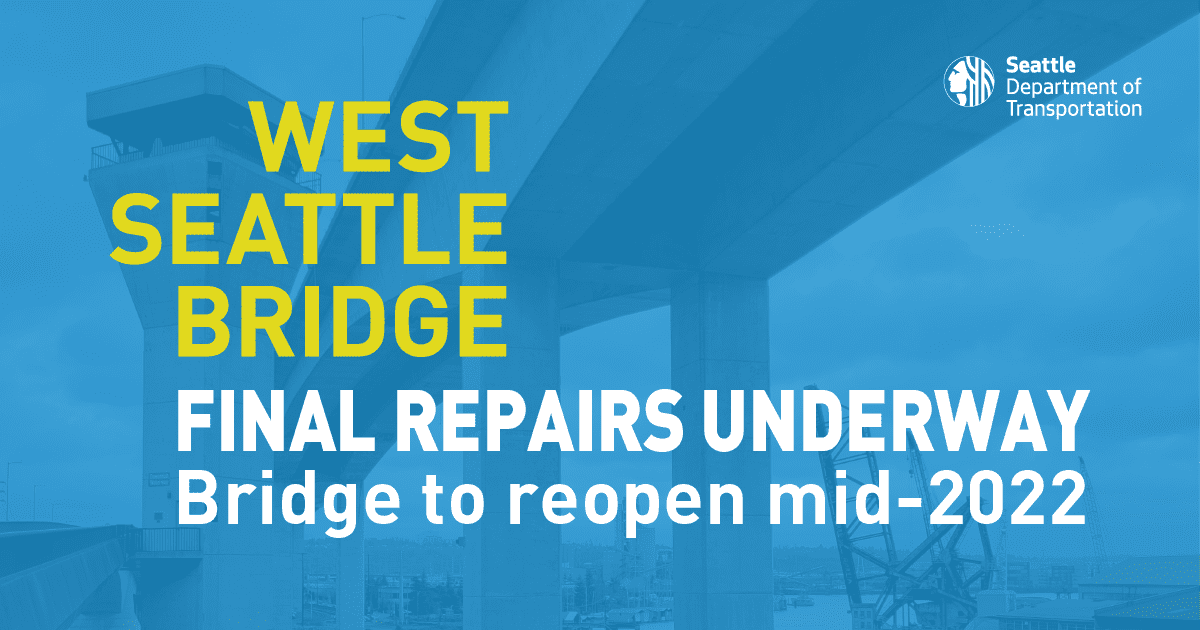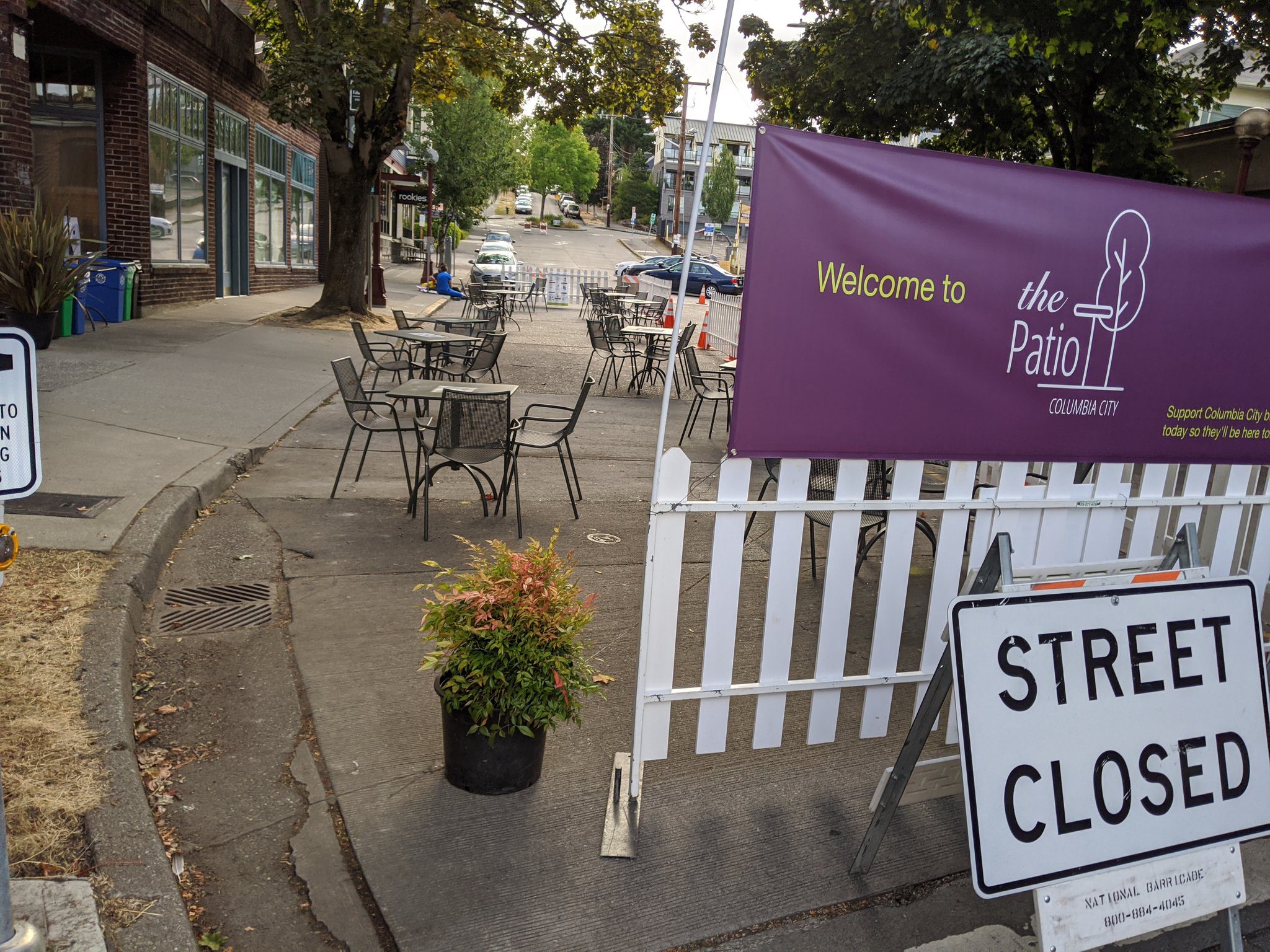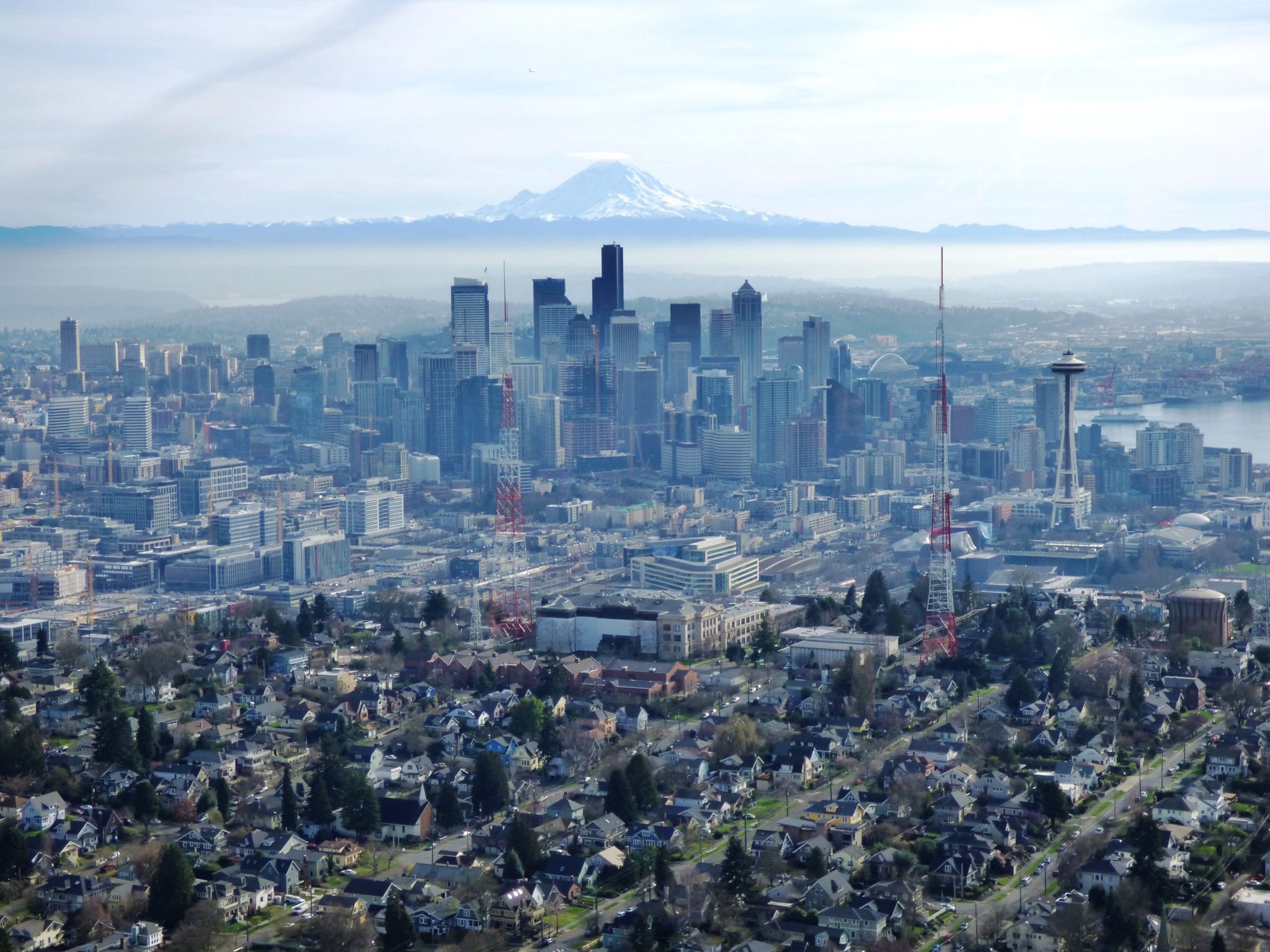 Aerial view of the city of Seattle. Photo credit: Ethan Bancroft & WSDOT.
Aerial view of the city of Seattle. Photo credit: Ethan Bancroft & WSDOT. Summary:
- 2021 was a year of major achievements, as well as work to address numerous challenges head-on. This Blog post includes 15 highlights from the past year, as well as a brief preview of 2022.
- Please read on to learn more, or click on the links below to jump to a specific highlight:
- Secured more than $151 million in new funding grants
- Opened new protected bike lanes in multiple locations across the city
- Completed the new John Lewis Memorial Bridge at Northgate
- Completed the Fairview Ave N Bridge Replacement Project
- Began final phase of West Seattle Bridge repairs and on-track to reopen in mid-2022
- Continued Safe Start permit program to allow street and sidewalk cafés, restaurants, and retail with a streamlined process
- Broke ground on Madison – RapidRide G Line project
- Provided new connections in Uptown near the new Climate Pledge Arena
- Installed over 1,500 curb ramps to meet ADA accessibility standards, exceeding our annual target of 1,250
- Tallied 1.4 million scooter share trips since the pilot program started and welcomed a new bike share provider
- Ensured equity remained a top priority, in close partnership with our Transportation Equity Workgroup
- Installed traffic camera enforcement pilot program that will ticket drivers for using transit lanes or blocking intersections and crosswalks
- Welcomed Seattle Parking Enforcement to the SDOT team
- Celebrated a new community street mural at Lake City’s Little Brook Stay Healthy Street
- Engaged with community members through a wide range of digital platforms and in-person on topics of interest
This past year was full of highs and lows. Our team successfully completed numerous large-scale projects to improve access and mobility, made progress toward repairing and safely reopening the West Seattle Bridge in mid-2022, and provided high-quality services to our constituents across the city of Seattle. Meanwhile, we also navigated the challenges and uncertainties of the ongoing COVID-19 pandemic and recorded a significant number of traffic collisions and fatalities on city streets over the past 12 months.
Through it all, Team SDOT remained dedicated to our mission to deliver a transportation system that provides safe and affordable access to places and opportunities. In support of this mission, we took action to advance our six core values and goals, which are: Equity, Safety, Mobility, Sustainability, Livability, and Excellence.
Read on to learn more about some specific examples of highlights and accomplishments from 2021. At the end, we’ve also provided a brief look-ahead to our work in the new year.
1) Secured more than $151 million in new funding grants
In 2021, we secured over $151 million in grants, including significant federal funding. These grants support numerous projects across the city. They help complete funding packages and allow our limited local funds to stretch further. We saw significant boosts in several key areas, including our bridge program (which includes the West Seattle Bridge), transit services, paving and maintenance programs, and pedestrian/bicycle projects.
While grant funding can sometimes be difficult to predict, the grants we secured in 2021 significantly exceeded our typical annual average for a calendar year! The East Marginal Way S Corridor Improvement Project, for example, was awarded a $20 million federal grant in November 2021 from the U.S. Department of Transportation. The Levy to Move Seattle also funds this project.
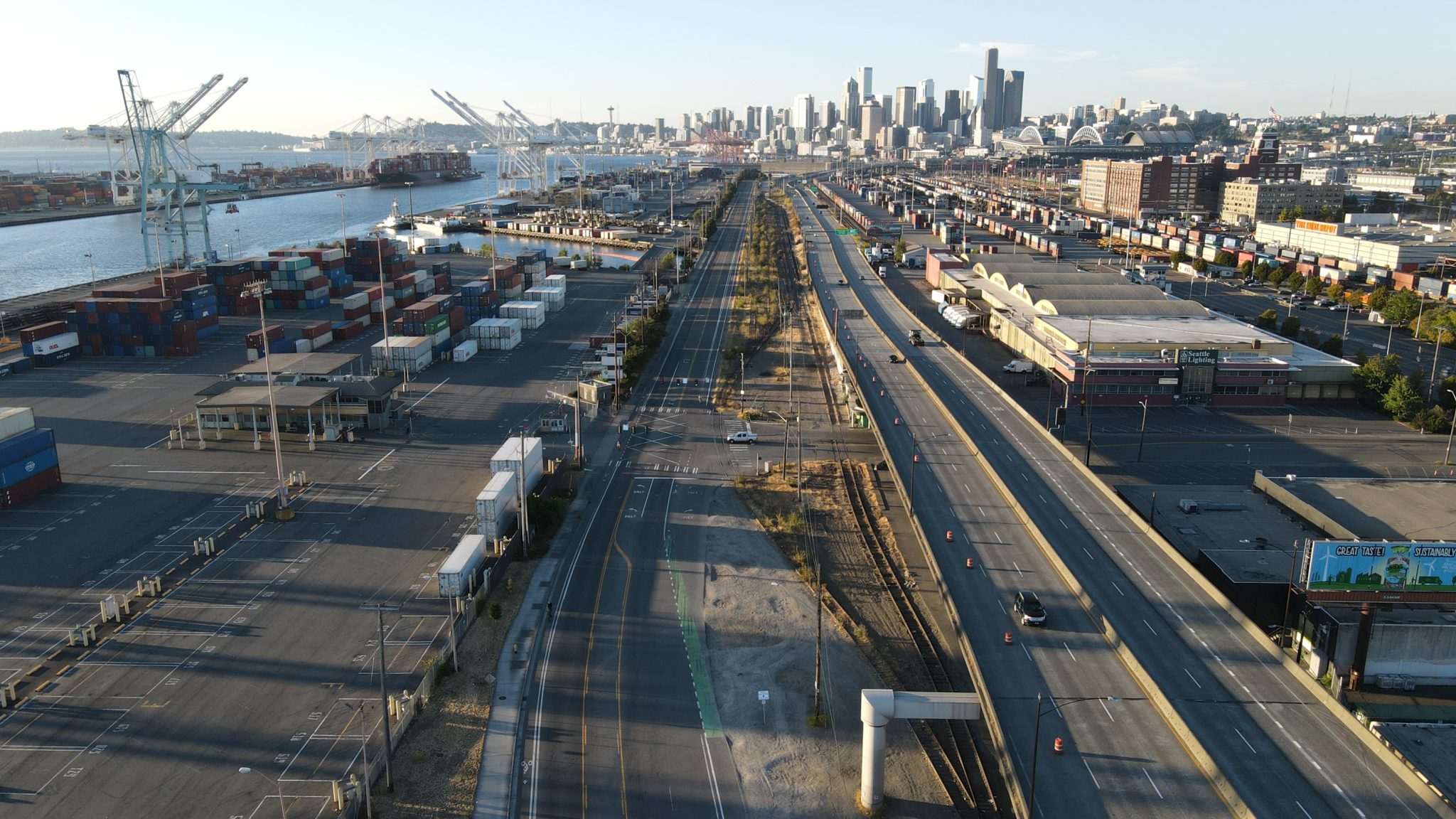
2) Opened new protected bike lanes in multiple locations across the city
(Funded by the Levy to Move Seattle!)

This was a major year for our bike program! In 2021, we completed pivotal projects, including opening new protected bicycle lanes on 4th Ave in downtown Seattle, along Green Lake Way, and on 12th Ave S in the Little Saigon neighborhood, connecting to North Beacon Hill via the Jose Rizal Bridge.
In total, we built nearly 10 miles of new protected bike lanes and trails! These new routes directly improve the mobility landscape of Seattle and make it safer and more inviting for people to bike, roll, and walk.
We also advanced several other bicycle-related efforts:
- We provided bicycles and safety lights to students in the Southeast Seattle community.
- We advanced numerous Safe Routes to School projects, and resumed the Let’s Go and Let’s Go Further program providing bike safety skills education to around 10,000 elementary and middle school students – the largest program of its kind in the country. The program is expected to reach up to 25,000 local students in the 2024-2025 academic year.
- We continued funding the Outdoors for All Program to provide the joy of biking to youth and people with disabilities via free rentals from a fleet of over 200 adaptive cycles at Magnuson Park and at events throughout the city.
- We continued our popular Stay Healthy Streets program and have continued planning, design, and implementation to make this long-term program permanent.
- We refined the Burke-Gilman Trail Missing Link project, which could begin construction as soon as this year and open in 2023.

3) Completed the new John Lewis Memorial Bridge at Northgate – part of a national award-winning effort to provide safe, multimodal connections!
(Funded by the Levy to Move Seattle!)

On Saturday, October 2, the John Lewis Memorial Bridge officially opened to people walking, rolling, and biking! We were pleased to welcome more than 1,000 community members to join the celebration.
The John Lewis Memorial Bridge helps knit back together a community historically divided by Interstate 5. We shared in this Blog post the significance of naming the bridge after Congressman Lewis and forever honoring his legacy and life’s work in the civil rights movement and public service in the U.S. Congress over several decades. People can now safely walk, bike, and roll across the John Lewis Memorial Bridge to head to school, work, and the new Northgate Link light rail station.
In December, we won a major award from TransitCenter, a national foundation that works to improve public transit and urban mobility through grantmaking, research, technical assistance, and public programs in cities across the country.
TransitCenter’s annual “Frequency” Awards recognize outstanding work by transit agencies, workers, and advocates to improve transit service. This year, they jointly selected SDOT, Sound Transit, King County Metro, and Community Transit for the “Best Transit Expansion” award of 2021! The award recognizes the regional coordination and infrastructure improvements that went into the Northgate Link transit expansion, including our work to support access and multimodal connections in the area via the John Lewis Memorial Bridge.
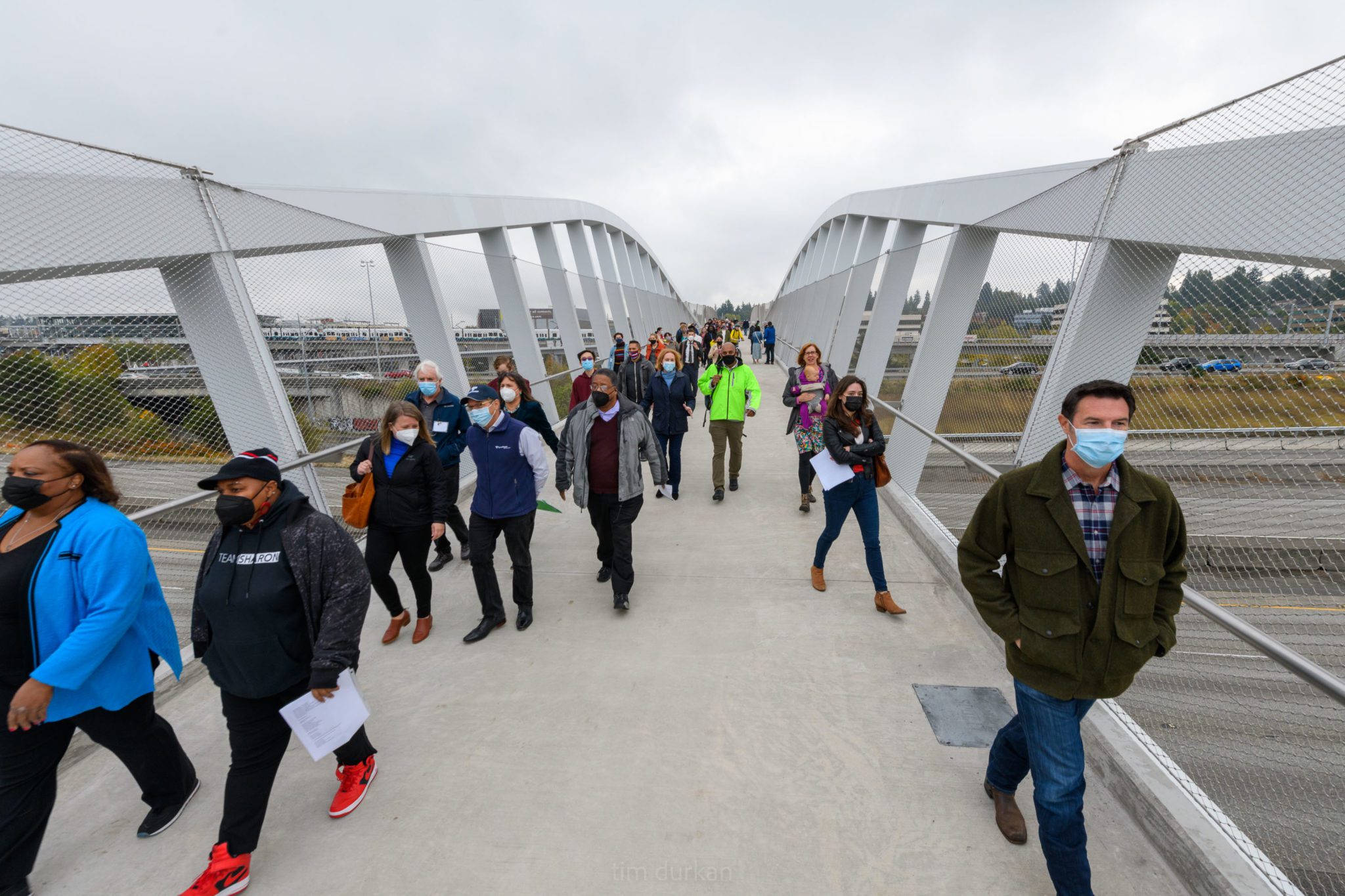
Along with the new pedestrian and bicycle bridge over I-5, we built a variety of protected bike lanes, greenways, improved sidewalks, and other safety and mobility enhancement projects in north Seattle to create family-friendly, accessible routes to and from the three new light rail stations at Northgate, Roosevelt, and the University District.
4) Completed the Fairview Ave N Bridge Replacement Project
(Funded by the Levy to Move Seattle!)

On July 24, we hosted a grand opening event with neighbors to celebrate the completion of the new Fairview Ave N Bridge. This project is one of the largest investments of our Levy to Move Seattle tax dollars (along with the Madison RapidRide G Line, which is also funded by the Levy, and covered further below in highlight #7).
In addition to seismic and structural safety improvements, the Fairview Ave N Bridge offers improvements for all travelers. There are now sidewalks on both sides of the street and a protected 12-foot two-way bike lane on the west side of the bridge overlooking the water. The floating walkway along the water below the west side of the bridge was also restored, and now includes three new lookout platforms that provide great views of Lake Union.
The bridge is also a key part of the future RapidRide J Line route, which will connect people to thousands of jobs in several of Seattle’s growing neighborhoods, including Belltown, South Lake Union, Eastlake, and the University District.
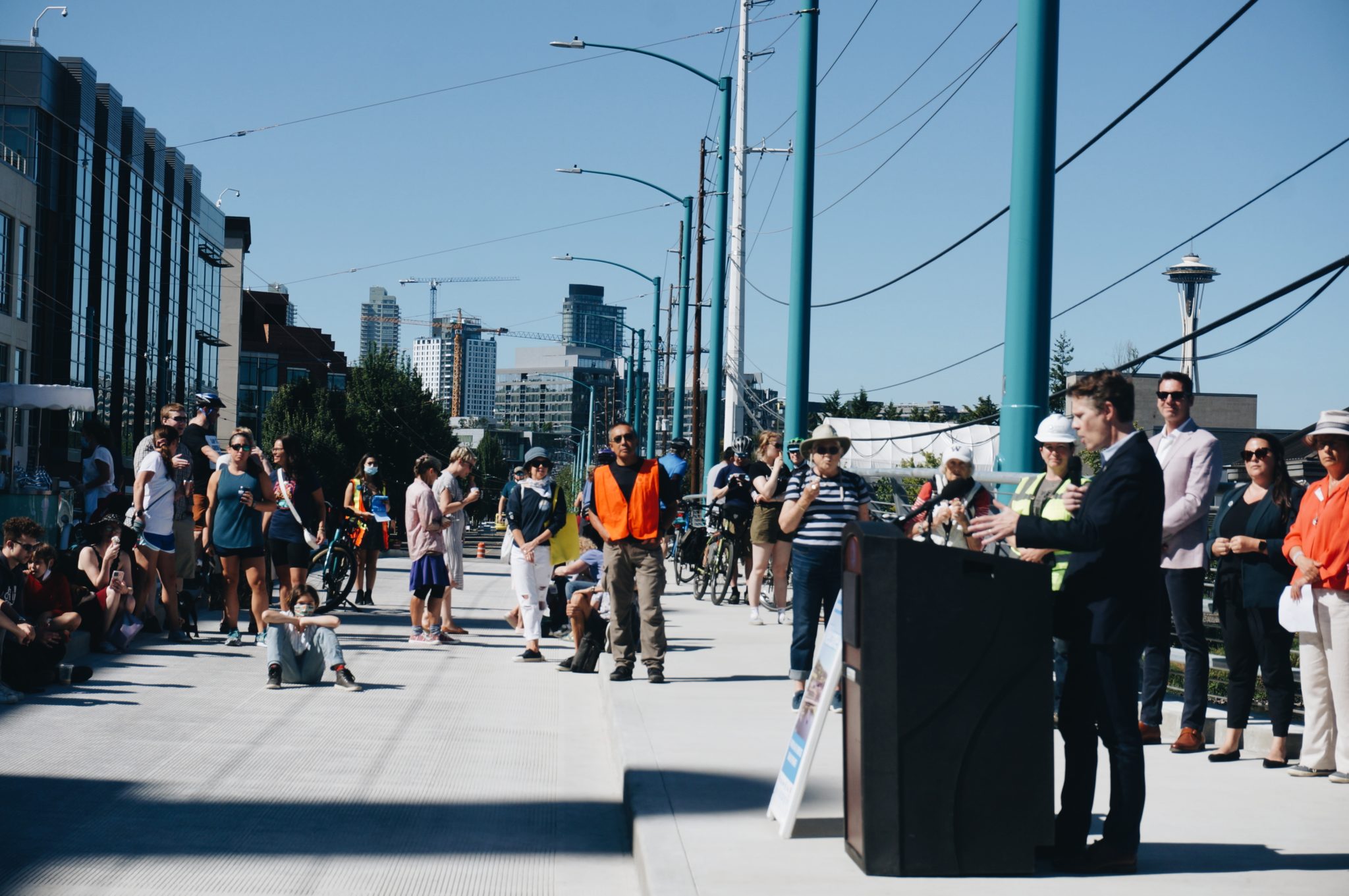
5) Began final phase of West Seattle Bridge repairs and on-track to reopen in mid-2022
We’ve been working hard to repair the West Seattle Bridge since it closed in March 2020. We completed the first phase of stabilization repairs in December 2020. In 2021, we finished the design for the remaining repairs to the bridge and selected a specialized contractor to complete this work.
On November 29, 2021, we shared that final repair work is underway. Construction crews have returned to the West Seattle Bridge to begin the final phase of the high-priority work to repair the bridge and prepare it for reopening in mid-2022. We recently installed new work platforms to help advance the repair work. We’ll also add epoxy and carbon fiber wrap to the Spokane St Swing Bridge (low bridge) to fill any existing cracks and strengthen that bridge.
The final phase of repairs includes:
- Injecting epoxy into the cracks to seal them and prevent corrosion.
- Wrapping parts of the structure with carbon fiber-reinforced polymer for durability to strengthen the bridge, like putting a cast on a broken bone.
- Installing more tight steel cables called post-tensioning strands through the entire bridge. These strands reinforce the concrete, much like the bridge’s skeleton.
We know the ongoing closure of the West Seattle Bridge has been challenging for the West Seattle and Duwamish Valley communities, both for travel to vital destinations like work, childcare, and medical appointments, as well as due to increased traffic volumes on detour routes that pass through residential neighborhoods like Highland Park, South Park, and Georgetown.
We are investing in a range of neighborhood traffic mitigation projects, bike projects, freight projects, and other efforts to support mobility in these communities – a series of projects we call Reconnect West Seattle. Many of these projects are now complete, while others are underway or coming soon. You can find a full list of projects in the interactive map on our website, or read more in our latest quarterly report (Q3 2021).
We continue to prioritize a safe and efficient reopening of this major connection in mid-2022. Thank you again to residents, workers, businesses, and other travelers for your continued patience and understanding as we work to reopen the bridge as quickly as possible safely.
6) Continued Safe Start permit program to allow street and sidewalk cafés, restaurants, and retail with a streamlined process
Since June 2020, Safe Start permits have supported Seattle restaurants and small businesses during the COVID-19 pandemic by making it easier for businesses to open up outdoor spaces for dining, shopping, and other uses.
Our Safe Start permits include outdoor cafés, retail merchandise displays, food trucks, vending carts, and community street closures like The Patio in Columbia City (pictured to the right; photo credit: SDOT).
Through Safe Start permits, we were able to simplify the application process and waive permit application fees – which provides opportunities for businesses to serve customers safely outdoors by using streets, sidewalks, and curb spaces throughout Seattle. In total, more than 250 businesses throughout the City of Seattle have participated in the temporary Safe Start permit program.
This past summer, we held an online survey to request feedback from community members and business owners on how the program was working for them. The survey was open in July and August, and we received completed surveys from more than 10,000 people! The feedback was largely positive and supportive of the program and the types of street and sidewalk uses it allows. Thank you to everyone who participated, either as a business or community member enjoying a bite, sip, or purchase from these neighborhood businesses. Seattle City Councilmember Dan Strauss has introduced an extension of the program until January 31, 2023, while new rules are finalized.
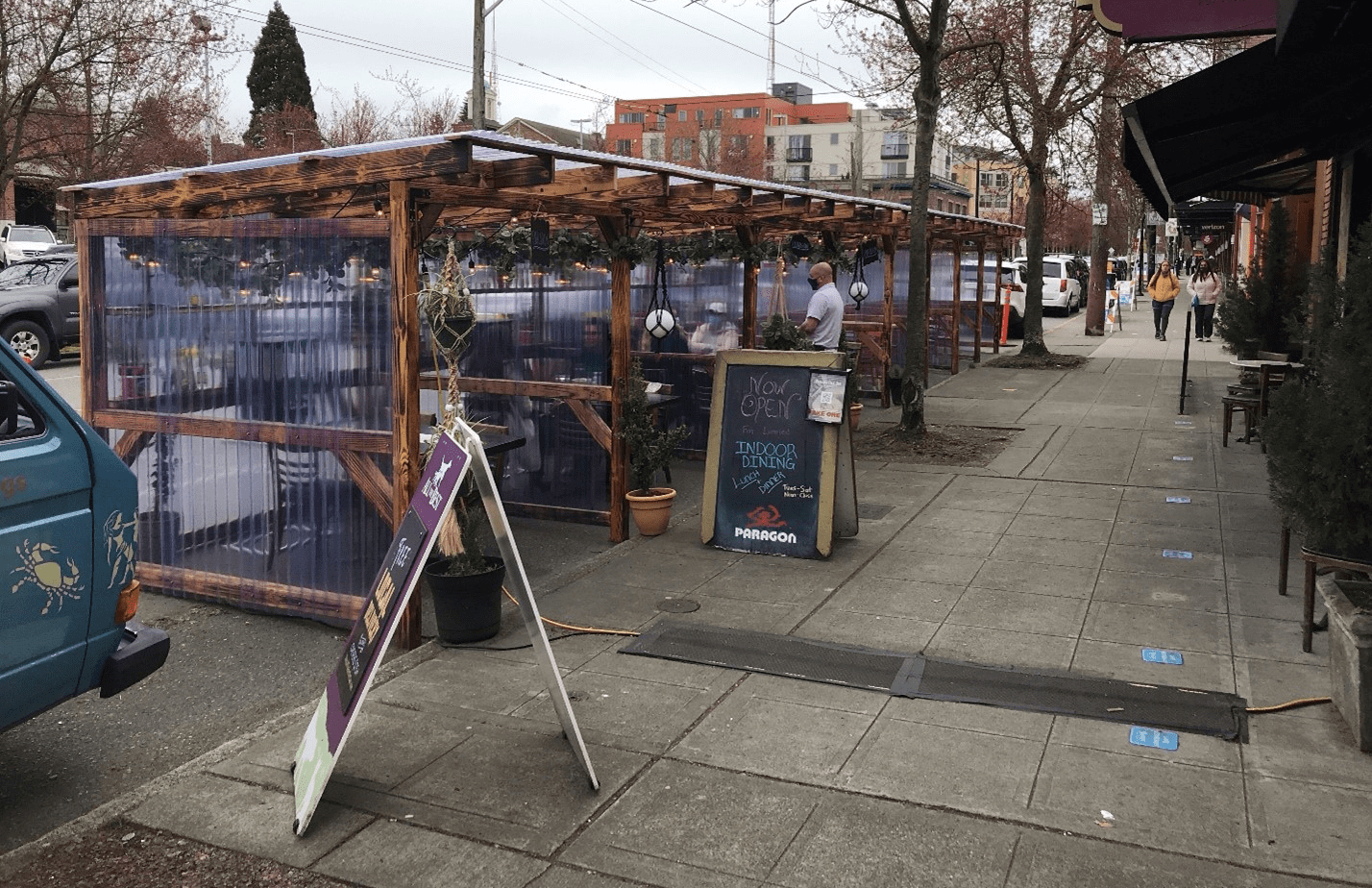
7) Broke ground on Madison – RapidRide G Line project – one of Seattle’s biggest Levy to Move Seattle-funded projects
(Funded by the Levy to Move Seattle!)

On September 30, we welcomed Federal Transit Administration (FTA) Administrator Nuria Fernandez to Seattle, alongside other local and regional leaders and congressional delegates, at a groundbreaking event to celebrate the start of construction on the Madison – RapidRide G Line.
This bus rapid transit (BRT) project is one of Seattle’s biggest projects funded by your tax dollars through the Levy to Move Seattle. When the Madison – RapidRide G Line opens in 2024, it will connect some of Seattle’s densest neighborhoods with frequent, reliable transit.
The Madison – RapidRide G Line is a partnership between us, King County Metro, and Sound Transit. It will create a frequent and reliable public transportation line between 1st Ave and Martin Luther King Jr Way. The route serves dense neighborhoods in downtown Seattle, First Hill, Capitol Hill, the Central District, and Madison Valley. The line will connect people to hospitals, schools and universities, and businesses as well as to dozens of bus routes, the First Hill Streetcar, the West Seattle and Vashon Water Taxi at Pier 50, and ferry service at the Colman Dock Ferry Terminal.
We look forward to continuing the construction of this major project and opening it to the public in 2024 and thank our community members in advance for their patience.
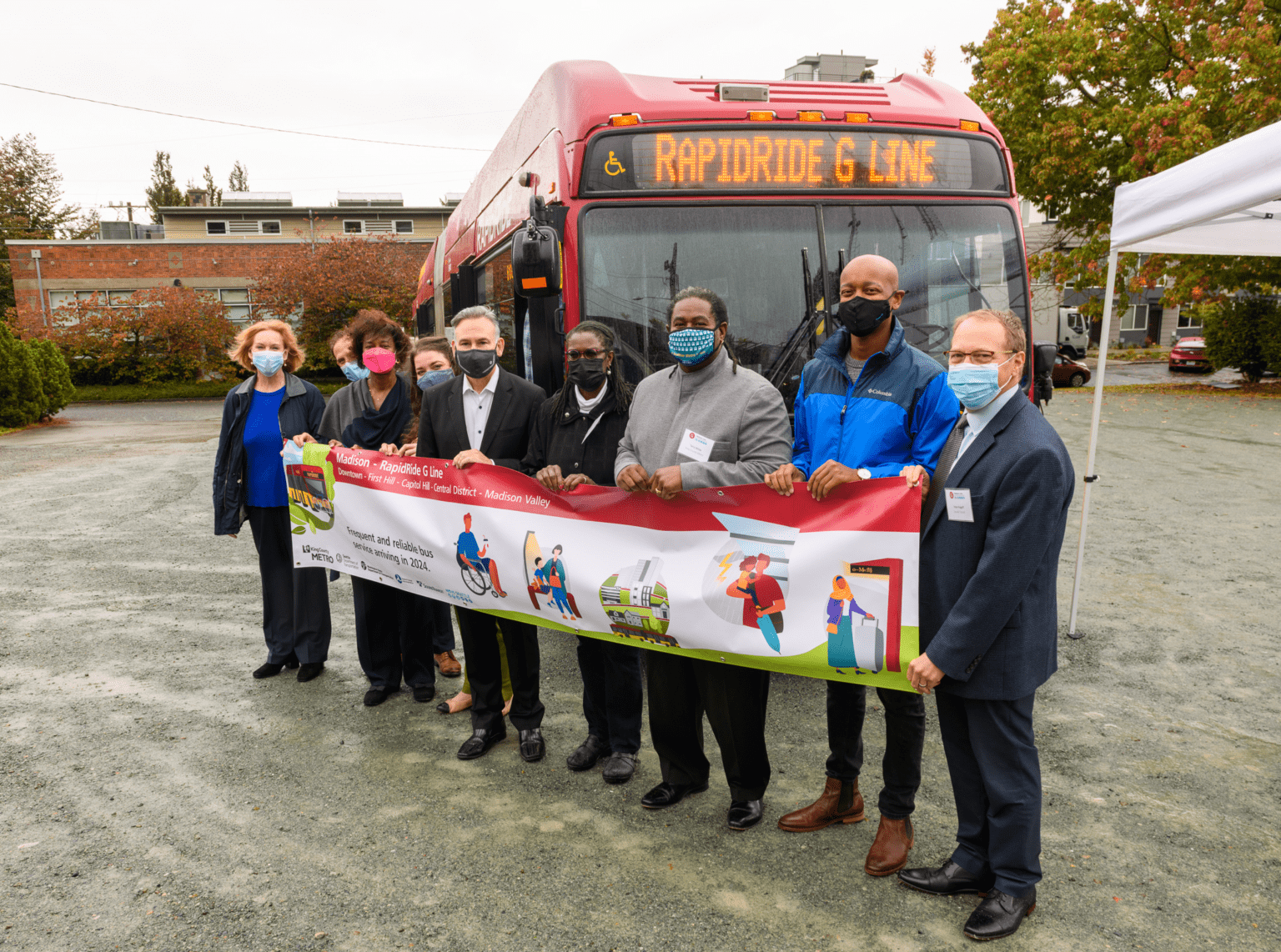
8) Provided new connections in Uptown near the new Climate Pledge Arena
In advance of the grand opening of the newly renovated Climate Pledge Arena this past October, we worked hard to complete a variety of new connections to make walking, biking, rolling, and taking transit more safe and predictable for getting around near the arena, both during major concerts and sports events, as well as during off-peak travel times.
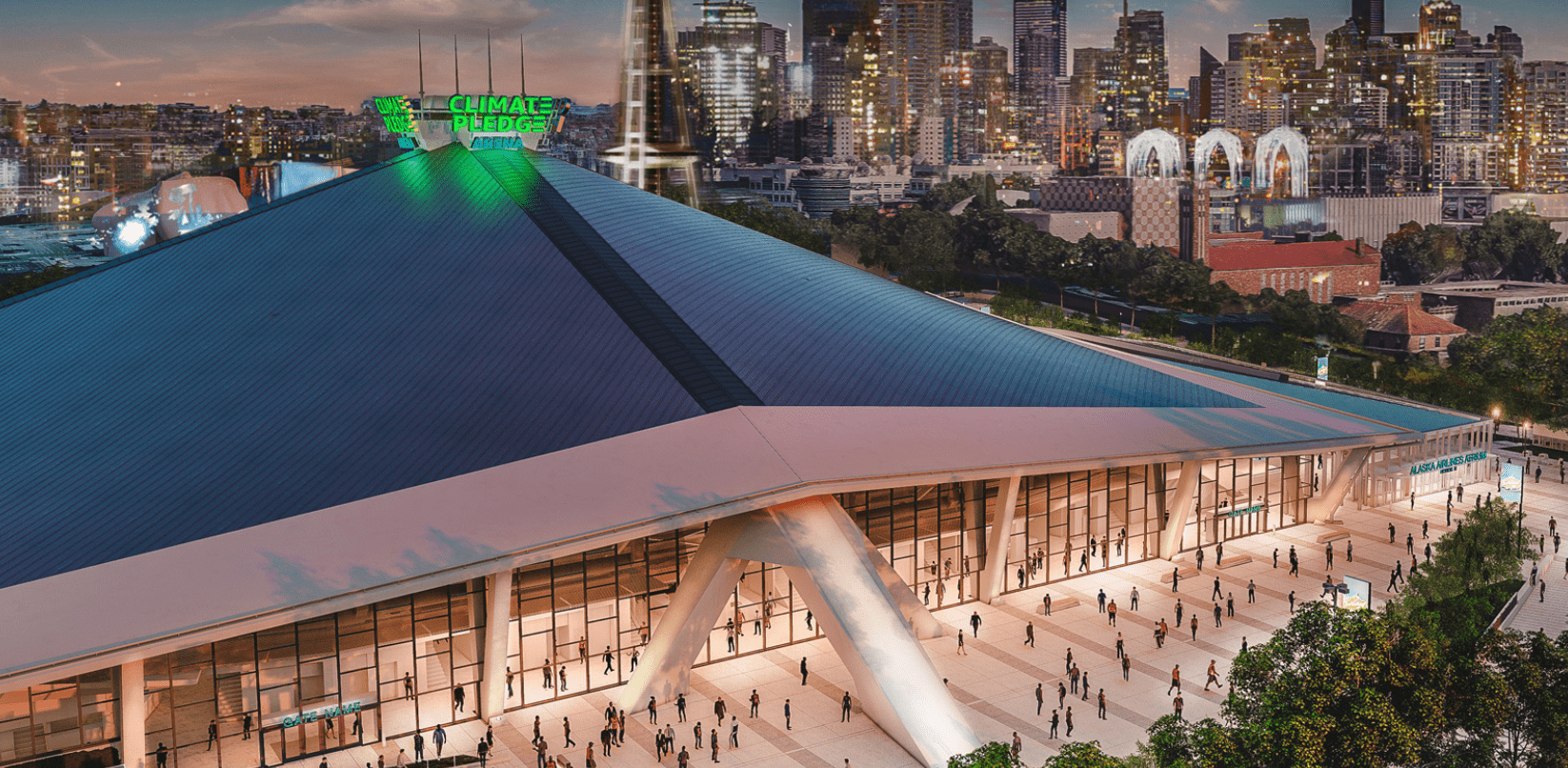
A few improvements we recently debuted include:
- New protected bike lanes along 1st Ave N, Thomas St, and Queen Anne Ave N support safer and more comfortable travel by bike or scooter to the new arena and throughout the Uptown neighborhood.
- New bus-only lanes along Queen Anne Ave N and 1st Ave N help ensure buses can move people more predictably before and after arena events and all other times of the day.
- Two new traffic signals improve traffic control and promote safety for people walking, biking, and rolling in the area.
- Wider pedestrian crossings and curb bulbs help accommodate larger crowds (at 1st Ave N and Harrison St, and 1st Ave N and Republican St).
- 157 new short-term bike parking stalls at the arena.
- The new Seattle Center to Waterfront Walking and Biking Connection links Climate Pledge Arena to Myrtle Edwards Park and the Elliott Bay Trail.
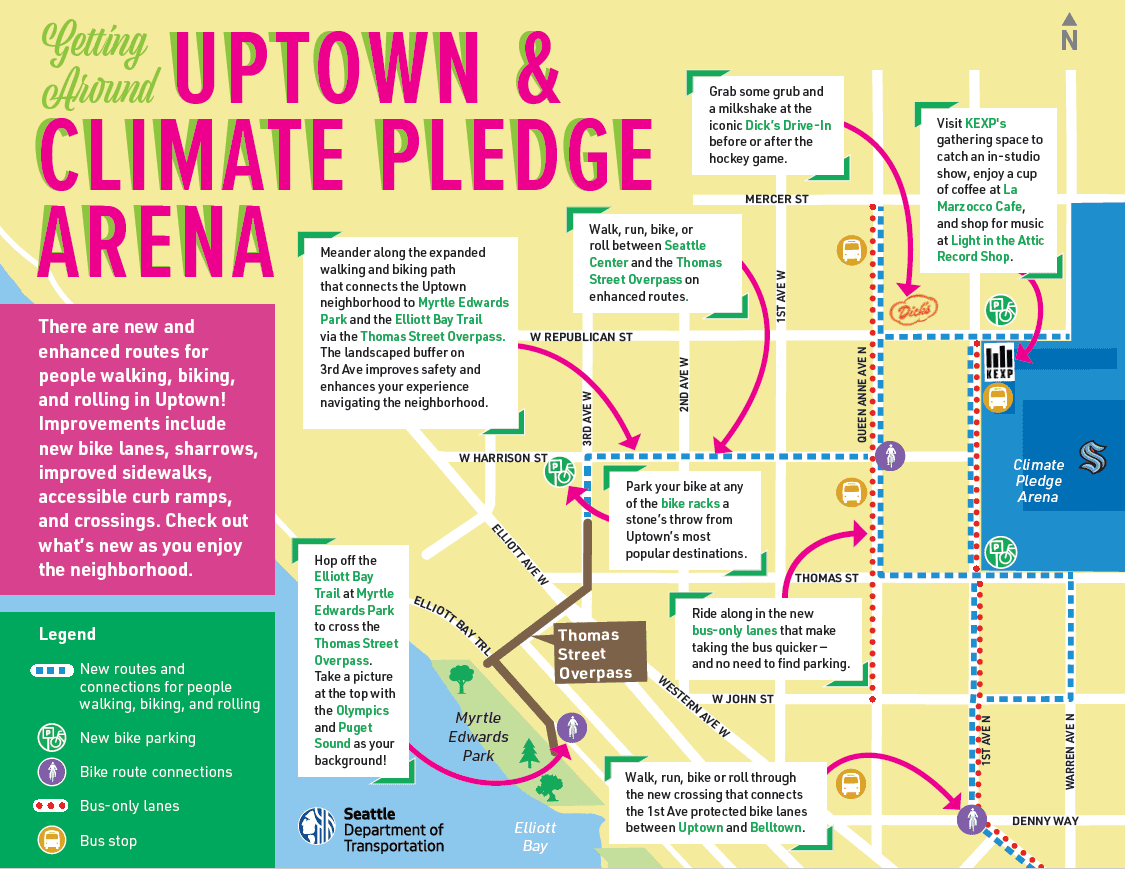
9) Installed over 1,500 curb ramps to meet ADA accessibility standards, exceeding our annual target of 1,250
(Funded by the Levy to Move Seattle!)

We continue to facilitate, design, and construct curb ramps that meet the Americans with Disabilities Act (ADA) accessibility requirements and allow people with disabilities, and everyone, to safely and easily use our sidewalks to get around.
In 2021, we successfully installed more than 1,500 curb ramps – significantly exceeding our annual target number of 1,250. This accomplishment sets us on a positive path to continue our efforts in 2022 and promote greater access and mobility for all.
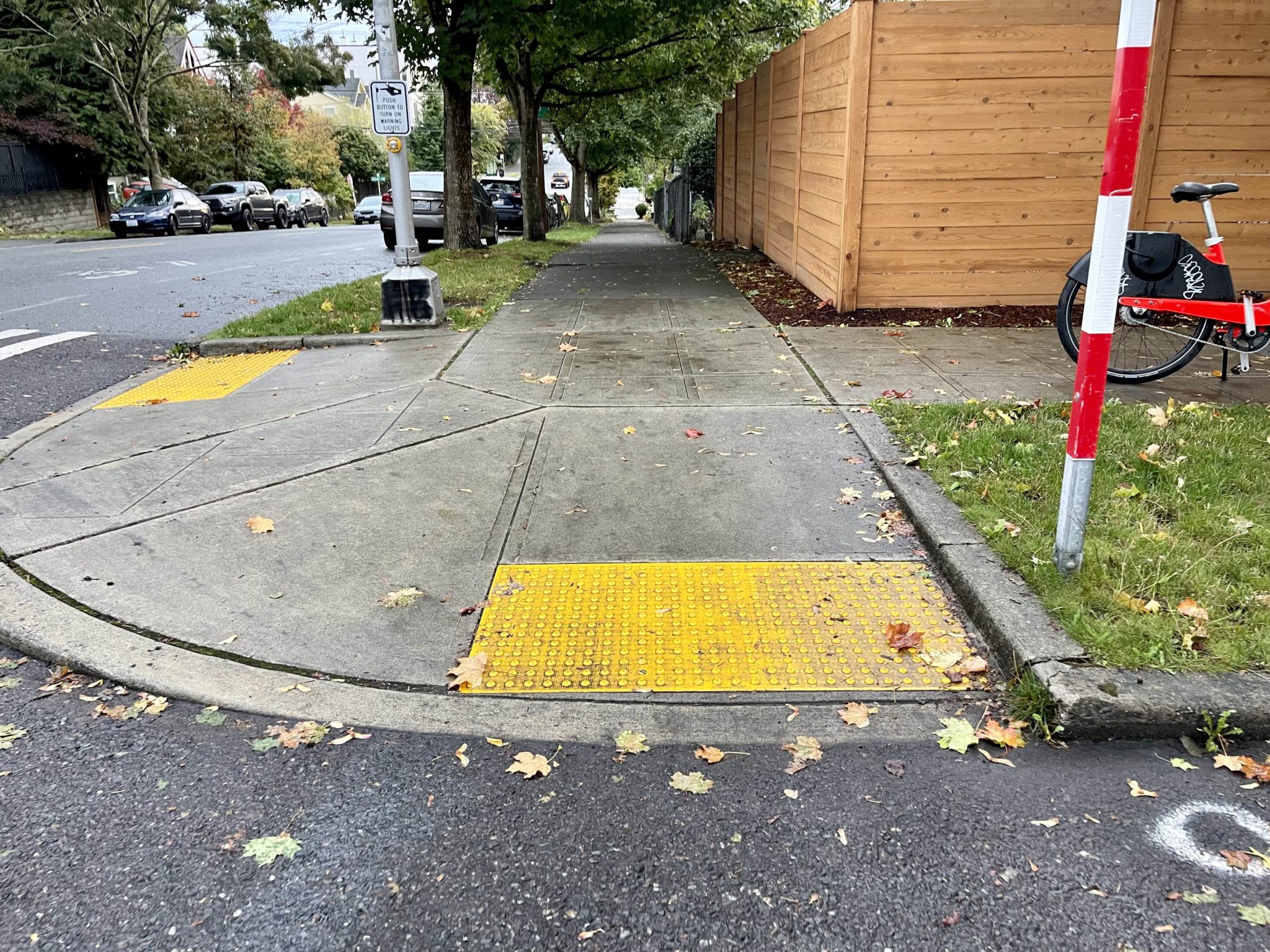
10) Tallied 1.4 million scooter share trips since the pilot program started and welcomed a new bike share provider
Our bike share and scooter share programs give residents and visitors healthy, climate-friendly, and active transportation options.
Since 2019, there have been nearly 2.9 million bike share trips and approximately 9.8 million miles traveled on bike share in Seattle. We estimate there have also been more than 2.2 million miles traveled through our scooter share program to date. All combined, that’s approximately 12 million total miles traveled! It’s like traveling around the Earth 482 times or from Earth to the moon 50 times!
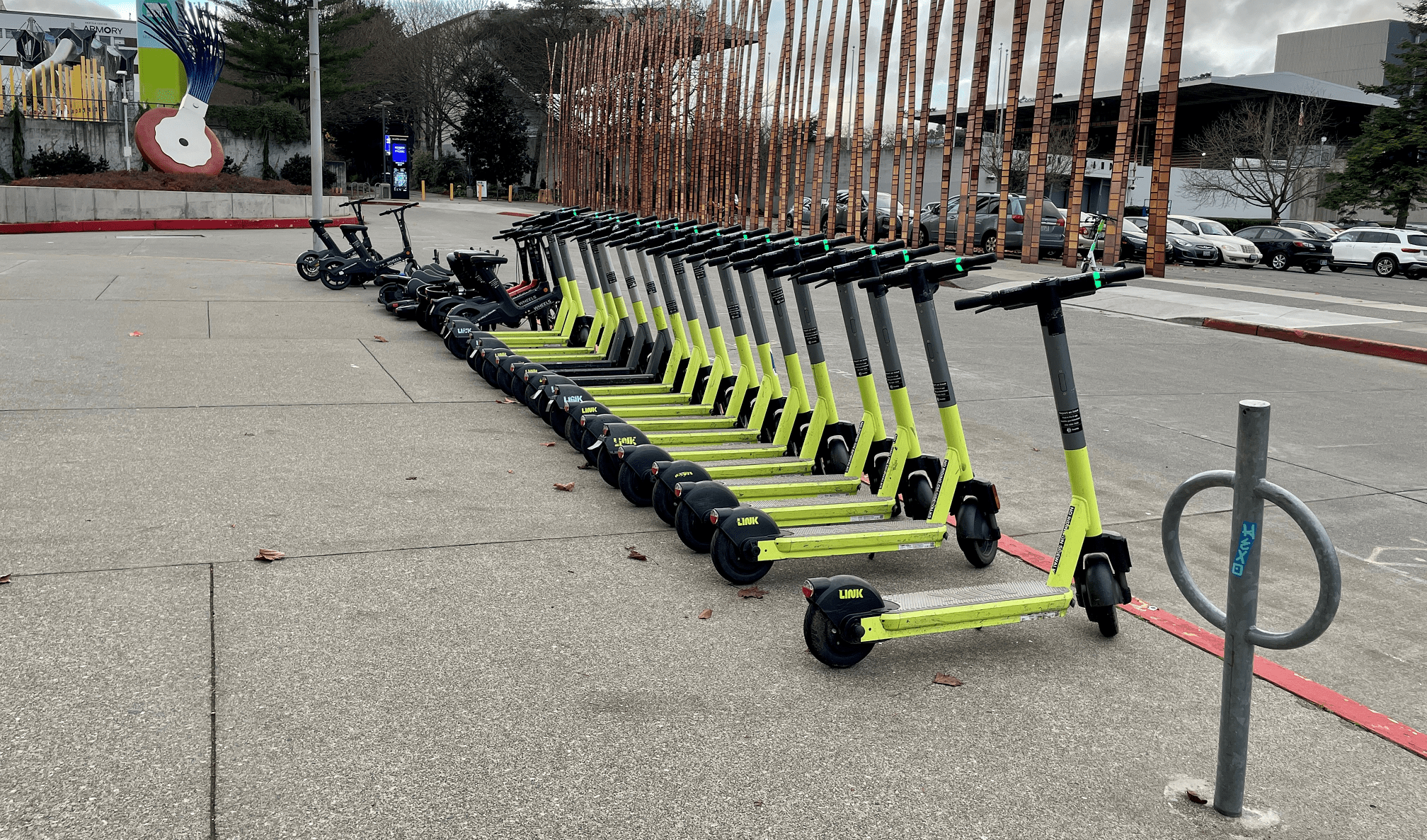
In December, Veo to become the newest bike share provider to operate in the city of Seattle, along with Lime, which is the other current bike share operator.
Our recent blog post also includes important reminders about how and where to safely park bike share equipment to ensure it does not block access to sidewalks and curb ramps, particularly for people with disabilities or other mobility challenges. We need your help – please refresh yourself and pay close attention to these bike and scooter parking rules. Thank you!
To help address parking challenges, we’ve installed 3,000 new bike and scooter parking spaces since 2014, made it easier to report improper parking, and partnered with Rooted in Rights to create a 90-second video to increase awareness.
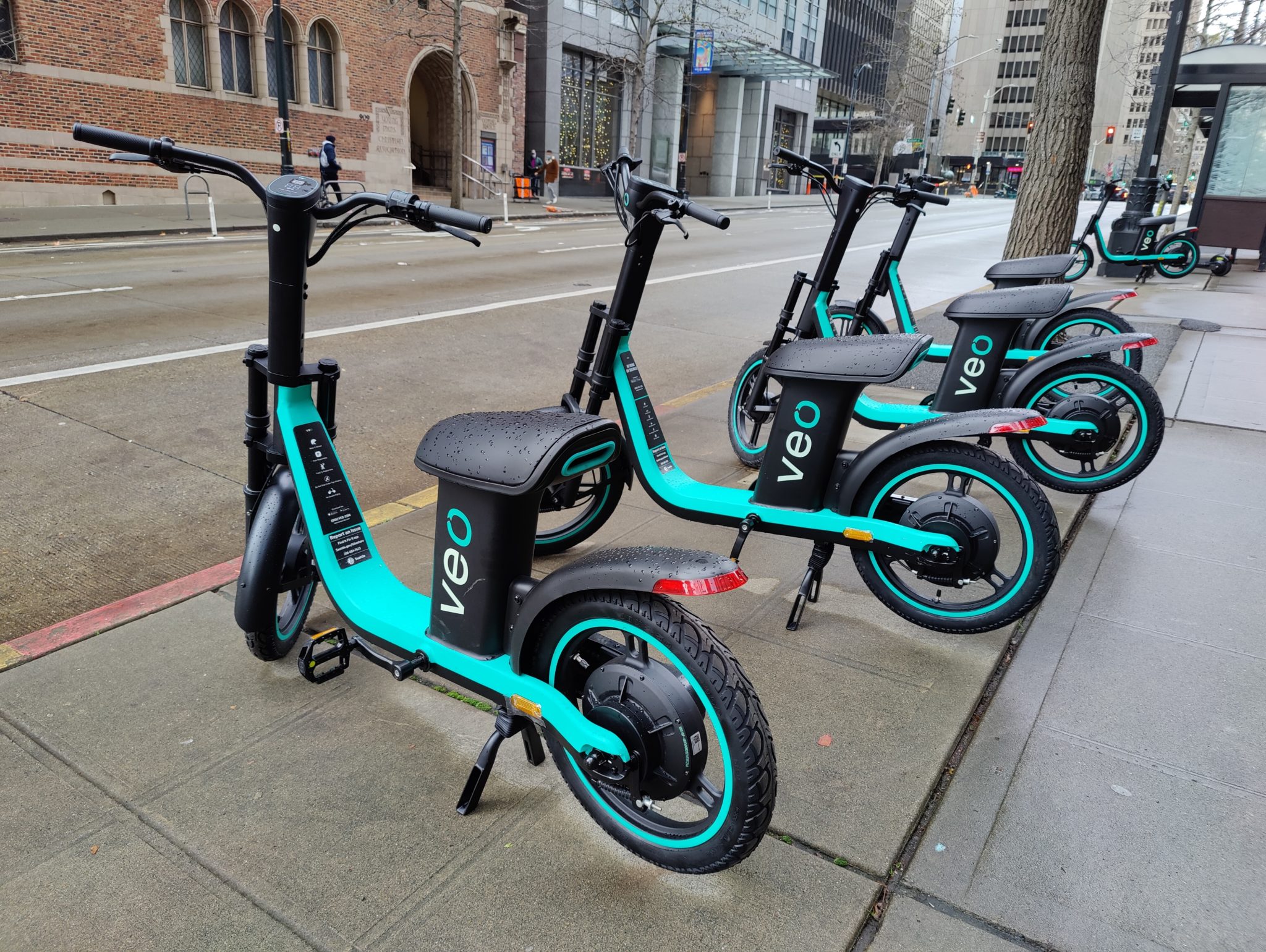
11) Ensured equity remained a top priority, in close partnership with our Transportation Equity Workgroup
Equity is one of our six core values and goals. Specifically, we believe transportation must meet the needs of communities of color and those of all incomes, abilities, and ages. Our goal is to partner with communities to build a racially equitable and socially just transportation system.
We are working to be a national leader among municipal transportation departments by ensuring that our policies, procedures, and practices adequately strive to address and ultimately undo structural and institutional racism.
For several years, we have been working closely with a group of community members on a Transportation Equity Workgroup to develop a Transportation Equity Framework and implementation plan. The workgroup’s efforts, as well as our public engagement and community conversations all across the city, have been essential to moving this work forward. Please stay tuned for additional updates about the equity workgroup’s activities and our progress in the new year.
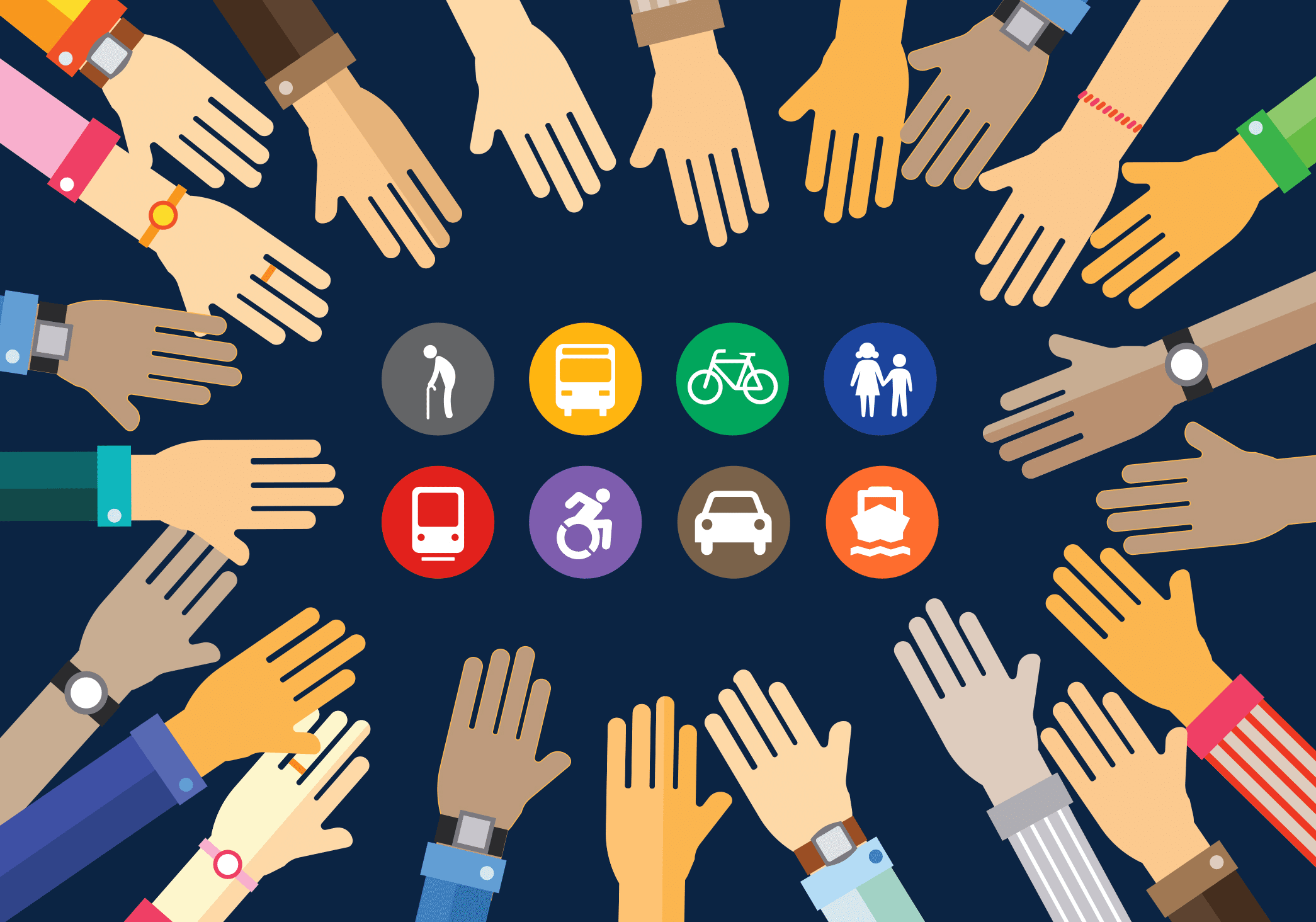
We also provide staff with resources and trainings on equity-related topics, empower our internal Race and Social Justice Change Team, and support our staff Employee Resource Groups to help fully integrate equity into our day-to-day work throughout the department moving forward.
12) Installed traffic camera enforcement pilot program that will ticket drivers for using transit lanes or blocking intersections and crosswalks
Starting the first quarter of 2022, our new traffic camera pilot program will automatically ticket drivers who illegally use transit lanes or block crosswalks and intersections.
The new traffic cameras will record the rear license plates of vehicles violating the law. The first time someone is caught, they are mailed a warning letter, and after that, they are mailed a $75 ticket. All locations will have clear signs and pavement markings, with white lines indicating where the intersection “box” begins and red paint indicating lanes restricted to buses only.
Cameras were installed in late 2021 when we launched an education campaign around the pilot program. These cameras are intended to help improve public safety, reduce congestion, keep transit moving, and increase mobility for people with disabilities. Cameras are in eight locations in downtown Seattle, South Lake Union, Belltown, Pioneer Square, and State Route 99.
These locations were chosen based on their history of problematic and ongoing violations of people blocking the intersection or driving in the transit lane. The cameras work like photo-enforcement cameras in other parts of Seattle, which issue tickets for red light violations or speeding in school safety zones. This means fewer police officers making in-person traffic stops so that police can focus on other public safety needs. It also makes enforcement more consistent, objective, and fair.
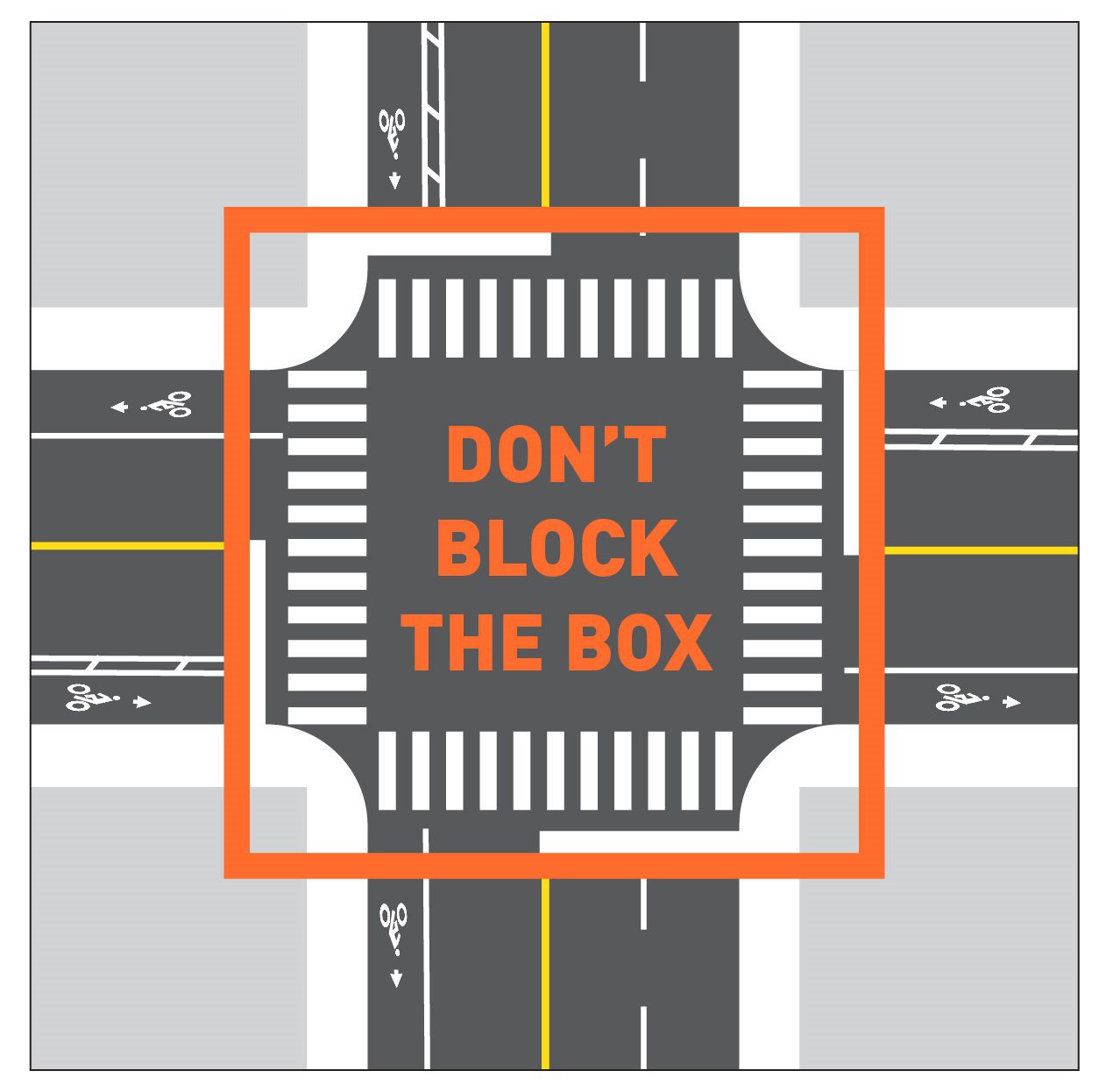
13) Welcomed Seattle Parking Enforcement to the SDOT team
Building on a decades-long history of the Seattle Parking Enforcement team working closely with our curb space management team, this year, we welcomed over 100 new employees as our parking enforcement professionals were transitioned from the Seattle Police Department to SDOT in the fall of 2021.
Our responsibility for effectively managing the public right of way fits hand and hand with Parking Enforcement’s core mission and current responsibilities. Effective right of way and curb space management is fundamental to a livable city, and parking enforcement is an essential component of ensuring sufficient parking spaces remain available to use.
We’re excited the Parking Enforcement team has joined us and look forward to learning from their direct knowledge and first-hand experience working throughout the city. Welcome to SDOT!
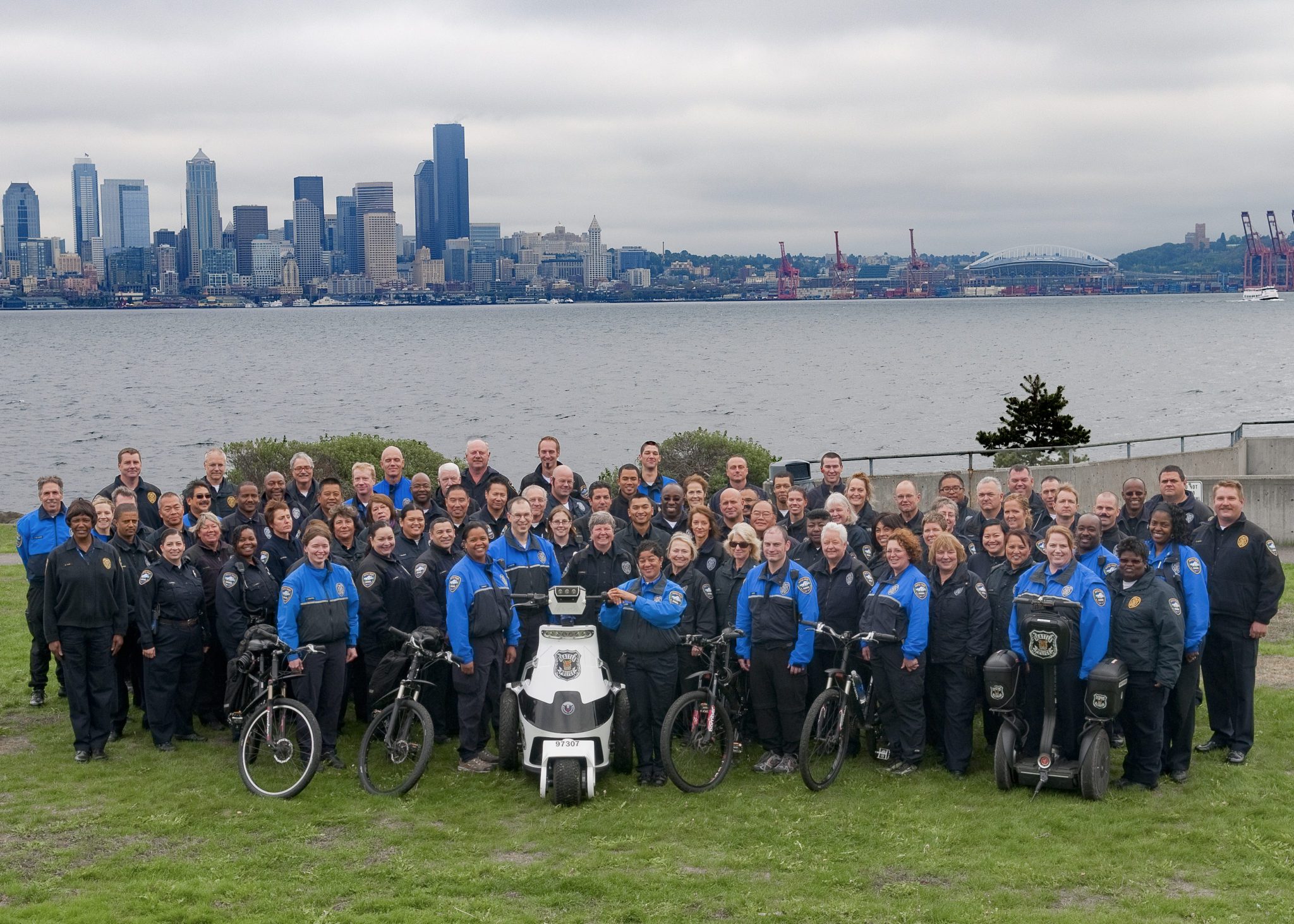
14) Celebrated a new community street mural at Lake City’s Little Brook Stay Healthy Street
We partnered with Lake City Collective to welcome the community to celebrate a new street mural in the Little Brook neighborhood of Lake City. The street mural was designed by Seattle artist Romel Belleza (Ilocano, Tlingit & Dishchii Bikoh N’Dee).
We installed the mural in partnership with Lake City Collective to honor Native culture and welcome people to the Little Brook neighborhood. Thank you, Romel, for creating this beautiful public artwork, as well as to our team led by Dahvee Enciso, who helped bring the mural to life at full scale, and completed the installation in just one day!
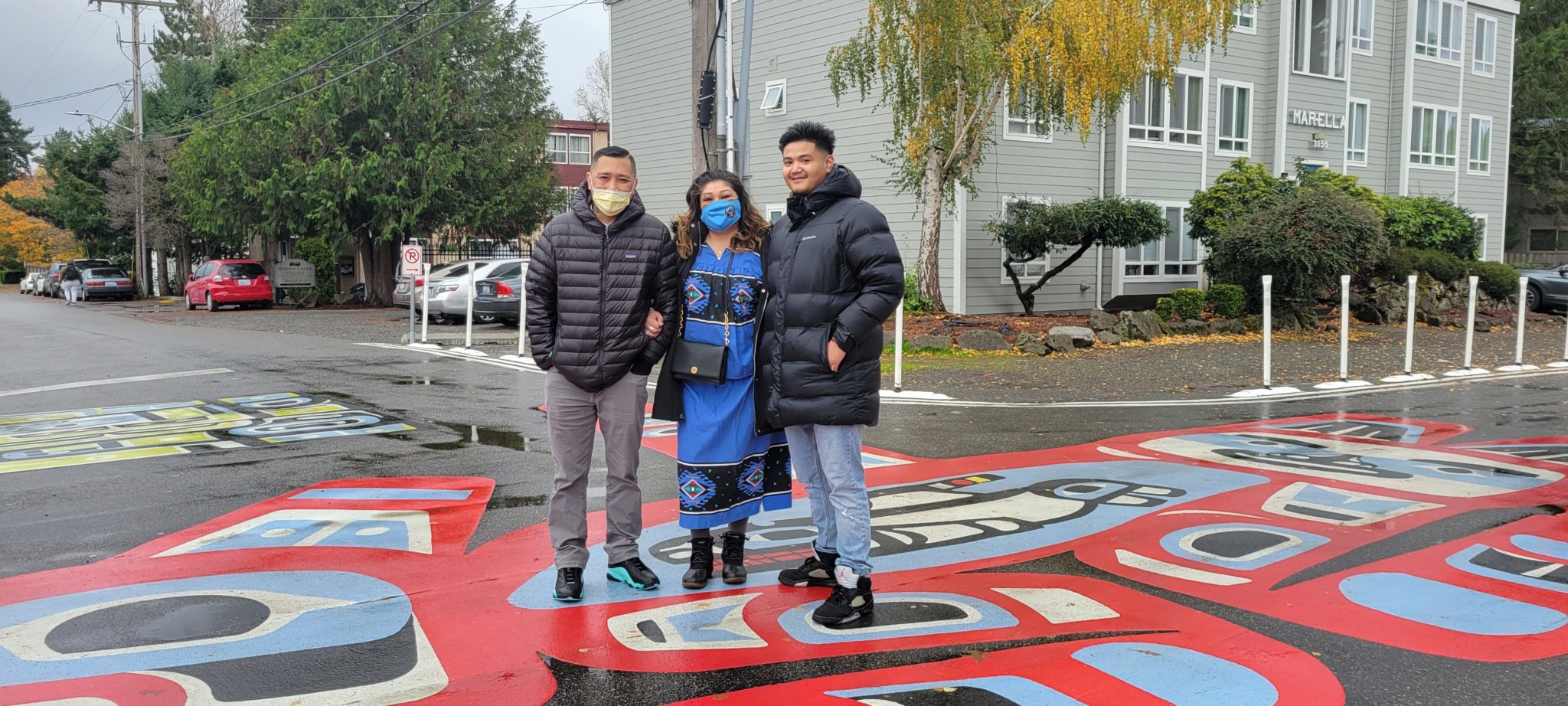
15) Engaged with community members through a wide range of digital platforms and in-person on topics of interest
Our Communications and Public Engagement team was busy again over the past year reaching community members about projects that affect them, upcoming construction activities, and new travel routes opening in local communities across the city. Our team leads media relations, community outreach, and digital engagement programs, including our SDOT Blog, social media channels (Facebook, Twitter, Instagram, LinkedIn (new!), YouTube, Flickr), and public email updates. More details are available on our Get Involved and Learn More web page.

Here are a few “By the Numbers” highlights from 2021:
- We responded to 633 media inquiries in 2021. This equals more than 50 per month.
- We published more than 300 SDOT Blog posts and tallied 412,000+ views on the Blog in 2021. The top post of the year was “Don’t Block the Box” and the automated traffic camera enforcement pilot program, with 27,000+ views and 3,500+ shares.
- We completed more than 600 different graphics to help visually and meaningfully showcase information to the public and SDOT stakeholders.
Along with online engagement, we also pursued in-person outreach while navigating the ongoing COVID-19 pandemic. We strive to meet people where they are and provide various options for the public to stay informed about our work and provide direct input. We attended many in-person meetings and events while observing public health and safety guidelines such as masking, social distancing, and gathering outside when possible. More information is available on our Outreach and Engagement web page.
Thank you for helping us shape the future of Seattle transportation by staying informed, getting involved, and sharing your perspectives.
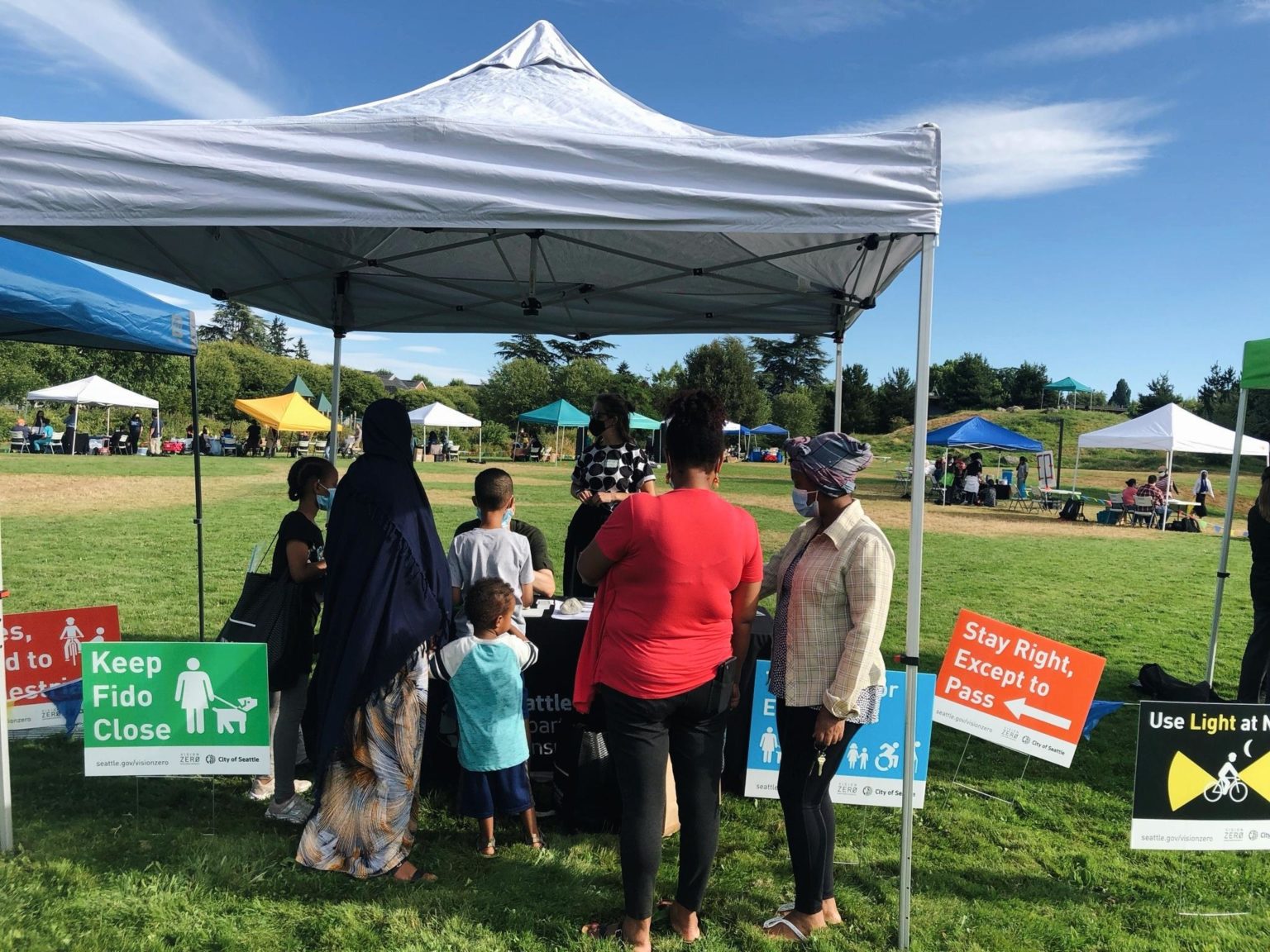
Onward to 2022!
Thank you for reading this far. Beyond these highlights, we accomplished a great deal more last year. Much of our most important work is done directly on the streets of Seattle, behind the wheel of a City vehicle, at a customer service counter, through a computer, around a planning table, or at a public event. Had it not been for the entire SDOT team working together day and night, we could not have delivered as much as we did.
We plan to build upon these achievements and continue to advance our mission, while working to provide a world-class transportation system for the city of Seattle and our region. This includes elevating safety, working to address climate change, integrating equity into all aspects of our work, and championing stewardship of our assets and resources – both today and for future generations.
We look forward to working with you, the entire city of Seattle community, to advance our values together. We will continue working together as One Seattle alongside our partner City departments to seamlessly serve the people of Seattle.
